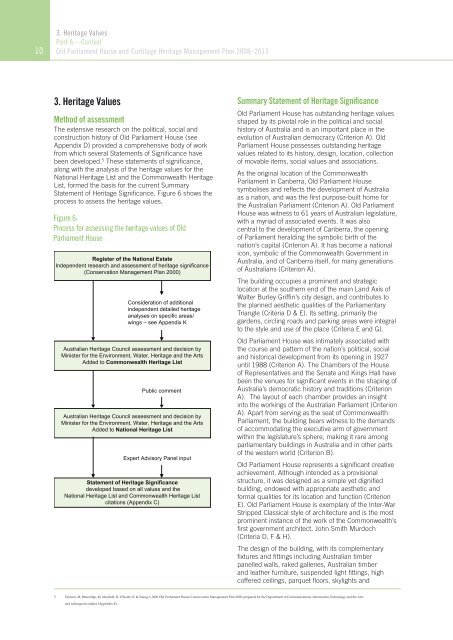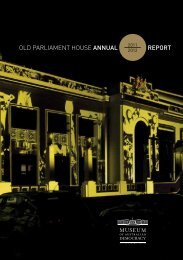OLD PARLIAMENT HOUSE AND CURTILAGE HERITAGE MANAGEMENT PLAN 2008–2013
Heritage Management Plan 2008-2013 - Museum of Australian ...
Heritage Management Plan 2008-2013 - Museum of Australian ...
- No tags were found...
You also want an ePaper? Increase the reach of your titles
YUMPU automatically turns print PDFs into web optimized ePapers that Google loves.
3. Heritage Values<br />
Part A – Context<br />
10 Old Parliament House and Curtilage Heritage Management Plan <strong>2008–2013</strong><br />
3. Heritage Values<br />
Method of assessment<br />
The extensive research on the political, social and<br />
construction history of Old Parliament House (see<br />
Appendix D) provided a comprehensive body of work<br />
from which several Statements of Significance have<br />
been developed. 5 These statements of significance,<br />
along with the analysis of the heritage values for the<br />
National Heritage List and the Commonwealth Heritage<br />
List, formed the basis for the current Summary<br />
Statement of Heritage Significance. Figure 6 shows the<br />
process to assess the heritage values.<br />
Figure 6:<br />
Process for assessing the heritage values of Old<br />
Parliament House<br />
Register of the National Estate<br />
Independent research and assessment of heritage significance<br />
(Conservation Management Plan 2000)<br />
Consideration of additional<br />
independent detailed heritage<br />
analyses on specific areas/<br />
wings – see Appendix K<br />
Australian Heritage Council assessment and decision by<br />
Minister for the Environment, Water, Heritage and the Arts<br />
Added to Commonwealth Heritage List<br />
Public comment<br />
Australian Heritage Council assessment and decision by<br />
Minister for the Environment, Water, Heritage and the Arts<br />
Added to National Heritage List<br />
Expert Advisory Panel input<br />
Statement of Heritage Significance<br />
developed based on all values and the<br />
National Heritage List and Commonwealth Heritage List<br />
citations (Appendix C)<br />
Summary Statement of Heritage Significance<br />
Old Parliament House has outstanding heritage values<br />
shaped by its pivotal role in the political and social<br />
history of Australia and is an important place in the<br />
evolution of Australian democracy (Criterion A). Old<br />
Parliament House possesses outstanding heritage<br />
values related to its history, design, location, collection<br />
of movable items, social values and associations.<br />
As the original location of the Commonwealth<br />
Parliament in Canberra, Old Parliament House<br />
symbolises and reflects the development of Australia<br />
as a nation, and was the first purpose-built home for<br />
the Australian Parliament (Criterion A). Old Parliament<br />
House was witness to 61 years of Australian legislature,<br />
with a myriad of associated events. It was also<br />
central to the development of Canberra, the opening<br />
of Parliament heralding the symbolic birth of the<br />
nation’s capital (Criterion A). It has become a national<br />
icon, symbolic of the Commonwealth Government in<br />
Australia, and of Canberra itself, for many generations<br />
of Australians (Criterion A).<br />
The building occupies a prominent and strategic<br />
location at the southern end of the main Land Axis of<br />
Walter Burley Griffin’s city design, and contributes to<br />
the planned aesthetic qualities of the Parliamentary<br />
Triangle (Criteria D & E). Its setting, primarily the<br />
gardens, circling roads and parking areas were integral<br />
to the style and use of the place (Criteria E and G).<br />
Old Parliament House was intimately associated with<br />
the course and pattern of the nation’s political, social<br />
and historical development from its opening in 1927<br />
until 1988 (Criterion A). The Chambers of the House<br />
of Representatives and the Senate and Kings Hall have<br />
been the venues for significant events in the shaping of<br />
Australia’s democratic history and traditions (Criterion<br />
A). The layout of each chamber provides an insight<br />
into the workings of the Australian Parliament (Criterion<br />
A). Apart from serving as the seat of Commonwealth<br />
Parliament, the building bears witness to the demands<br />
of accommodating the executive arm of government<br />
within the legislature’s sphere, making it rare among<br />
parliamentary buildings in Australia and in other parts<br />
of the western world (Criterion B).<br />
Old Parliament House represents a significant creative<br />
achievement. Although intended as a provisional<br />
structure, it was designed as a simple yet dignified<br />
building, endowed with appropriate aesthetic and<br />
formal qualities for its location and function (Criterion<br />
E). Old Parliament House is exemplary of the Inter-War<br />
Stripped Classical style of architecture and is the most<br />
prominent instance of the work of the Commonwealth’s<br />
first government architect, John Smith Murdoch<br />
(Criteria D, F & H).<br />
The design of the building, with its complementary<br />
fixtures and fittings including Australian timber<br />
panelled walls, raked galleries, Australian timber<br />
and leather furniture, suspended light fittings, high<br />
coffered ceilings, parquet floors, skylights and<br />
5 Pearson, M, Betteridge, M, Marshall, D, O’Keefe, B, & Young, L 2000 Old Parliament House Conservation Management Plan 2000, prepared for the Department of Communications, Information Technology and the Arts<br />
and subsequent studies (Appendix K).




